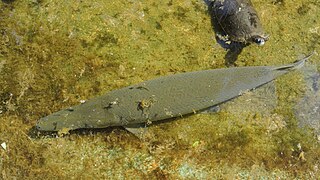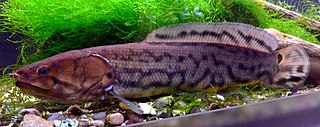
Gars are an ancient group of ray-finned fish in the family Lepisosteidae. They comprise seven living species of fish in two genera that inhabit fresh, brackish, and occasionally marine waters of eastern North America, Central America and Cuba in the Caribbean, though extinct members of the family were more widespread. They are the only surviving members of the Ginglymodi, a clade of fish which first appeared during the Triassic period, over 240 million years ago, and are one of only two surviving groups of holosteian fish, alongside the bowfins, which have a similar distribution.

The tropical gar is a species of fish from Central America, where it is found in the Pacific and Atlantic drainages from southern Mexico to Costa Rica. In Central America it is known as gaspar and in Mexico it is known as pejelagarto, a contraction of the words "pez" (fish) and "lagarto" (alligator). This gar inhabits a wide range of fresh and brackish water habitats such as rivers, floodplains, lakes and pools, but avoids areas with a strong current. It reaches lengths of up to 1.25 m (4 ft) and a weight up to 2.9 kg (6.4 lb). The tropical gar looks very similar to the longnose gar in color and markings, but can be distinguished by its shorter, broader snout. The tropical gar's diet consists mainly of cichlids and other fish.

The longnose gar, also known as longnose garpike or billy gar, is a ray-finned fish in the family Lepisosteidae. The genus may have been present in North America for about 100 million years. References are made to gars being a primitive group of bony fish because they have retained some primitive features, such as a spiral valve intestine, but they are not primitive in the sense of not being fully developed.

The alligator gar is a euryhaline ray-finned fish in the clade Ginglymodi of the infraclass Holostei, being most closely related to the bowfins. It is the largest species in the gar family (Lepisosteidae), and is among the largest freshwater fish in North America. The fossil record traces its group's existence back to the Early Cretaceous over 100 million years ago. Gars are often referred to as "primitive fishes" or "living fossils", because they have retained some morphological characteristics of their early ancestors, such as a spiral valve intestine, which is also common to the digestive system of sharks, and the ability to breathe in both air and water. Their common name was derived from their resemblance to the American alligator, particularly their broad snouts and long, sharp teeth. It is suggested that an alligator gar can grow up to 10 ft (3.0 m) in length.

Deinodon is a dubious tyrannosaurid dinosaur genus containing a single species, Deinodon horridus. D. horridus is known only from a set of teeth found in the Late Cretaceous Judith River Formation of Montana and named by paleontologist Joseph Leidy in 1856. These were the first tyrannosaurid remains to be described and had been collected by Ferdinand Vandeveer Hayden. The teeth of Deinodon were slightly heterodont, and the holotype of Aublysodon can probably be assigned to Deinodon.

Diplotomodon is a dubious genus of theropod dinosaur, from New Jersey. It was possibly a member of the Tyrannosauroidea, the clade that also contains Tyrannosaurus.
Diclonius is a genus of dinosaur from the Late Cretaceous. It was a hadrosaur based solely on teeth. Its fossils were found in the Judith River Formation of Montana, northern US. The name is in reference to the method of tooth replacement, in which newly erupting replacement teeth could be in functional use at the same time as older, more worn teeth. Thus, the number of "sprouting" teeth was doubled in comparison to Monoclonius, which used only one set of teeth at a time and which Cope named in the same paper.

The Florida gar is a species of gar found in the US from the Savannah River and Ochlockonee River watersheds of Georgia and throughout peninsular Florida. Florida gar can reach a length over 3 ft (91 cm). The young feed on zooplankton and insect larvae, as well as small fish. Adults mainly eat fish, shrimp, and crayfish. Although edible, they are not popular as food. The roe is highly toxic to many animals, including humans and birds.

The spotted gar is a freshwater fish native to North America that has an abundance of dark spots on its head, fins, and dart-like body. Spotted gar have an elongated mouth with many needle-like teeth to catch other fish and crustaceans. It is one of the smallest of the seven species of gar found in North America, growing 2–3 ft in length and weighing 4–6 lb (1.8–2.7 kg) typically. Gars have diamond-shaped, thick, enamel (ganoid) scales. The name Lepisosteus is Greek for "bony scale".

The shortnose gar is a primitive freshwater fish of the family Lepisosteidae. It is native to the United States where its range includes the Mississippi and Missouri River basins, ranging from Montana to the west and the Ohio River to the east, southwards to the Gulf Coast. It inhabits calm waters in large rivers and their backwaters, as well as oxbow lakes and large pools. It is a long, slender fish, brown or olive green above and whitish below. It typically grows to about 60 cm (24 in) and is armored by rows of interlocking, rhomboidal ganoid scales.

Atractosteus is a genus of gars in the family Lepisosteidae, with three extant species. It is one of two surviving gar genera alongside Lepisosteus.

The Cuban gar, also known as the manjuarí, is a fish in the family Lepisosteidae. It is a tropical, freshwater species, although it also inhabits brackish water. It is found in rivers and lakes of western Cuba and the Isla de la Juventud. The flesh of the fish is edible, but the eggs are poisonous for humans.

Amia, commonly called bowfin, is a genus of ray-finned fish related to gars in the infraclass Holostei. They are regarded as taxonomic relicts, being the sole surviving species of the order Amiiformes and clade Halecomorphi, which dates from the Triassic to the Eocene, persisting to the present. There are two living species in Amia, Amia calva and Amia ocellicauda, and a number of extinct species which have been described from the fossil record.

Obaichthyidae is an extinct family of ginglymodian ray-finned fish that lived in what is now Africa, South America, and southern Europe during the Cretaceous period. They were close relatives of the modern gars of the family Lepisosteidae, with the two groups making up the superfamily Lepisosteoidea.

Atractosteus grandei is an extinct species of gar in the family Lepisosteidae. Remains have been found in Lower Paleogene sediments from North Dakota. A. grandei belonged to the genus Atractosteus which includes modern day species of gars such as the giant alligator gar and the tropical gar. It is named after paleontologist and ichthyologist Lance Grande.

Cuneatus is an extinct genus of gar that inhabited western North America during the early Paleogene. As the genus name suggests, they are distinguishable from modern gar by their cuneate (wedge-shaped) heads, with a significantly shortened snout. Three species are known: C. cuneatus, C. maximus, and C. wileyi.
Oniichthys is an extinct genus of gar in the family Lepisosteidae. It contains a single species, O. falipoui, known from the Late Cretaceous (Cenomanian) of Morocco.
Herreraichthys is an extinct genus of gar from the Late Cretaceous of Mexico. It contains a single species, H. coahuilaensis. The genus name honors the famous Mexican scientist Alfonso L. Herrera.

Grandemarinus is an extinct genus of gar from the Late Cretaceous of Morocco. It contains a single species, G. gherisensis. The genus name honors evolutionary biologist Lance Grande and references the species' apparent marine nature, while the specific epithet references Oued Gheris, a wadi near the type locality.




















